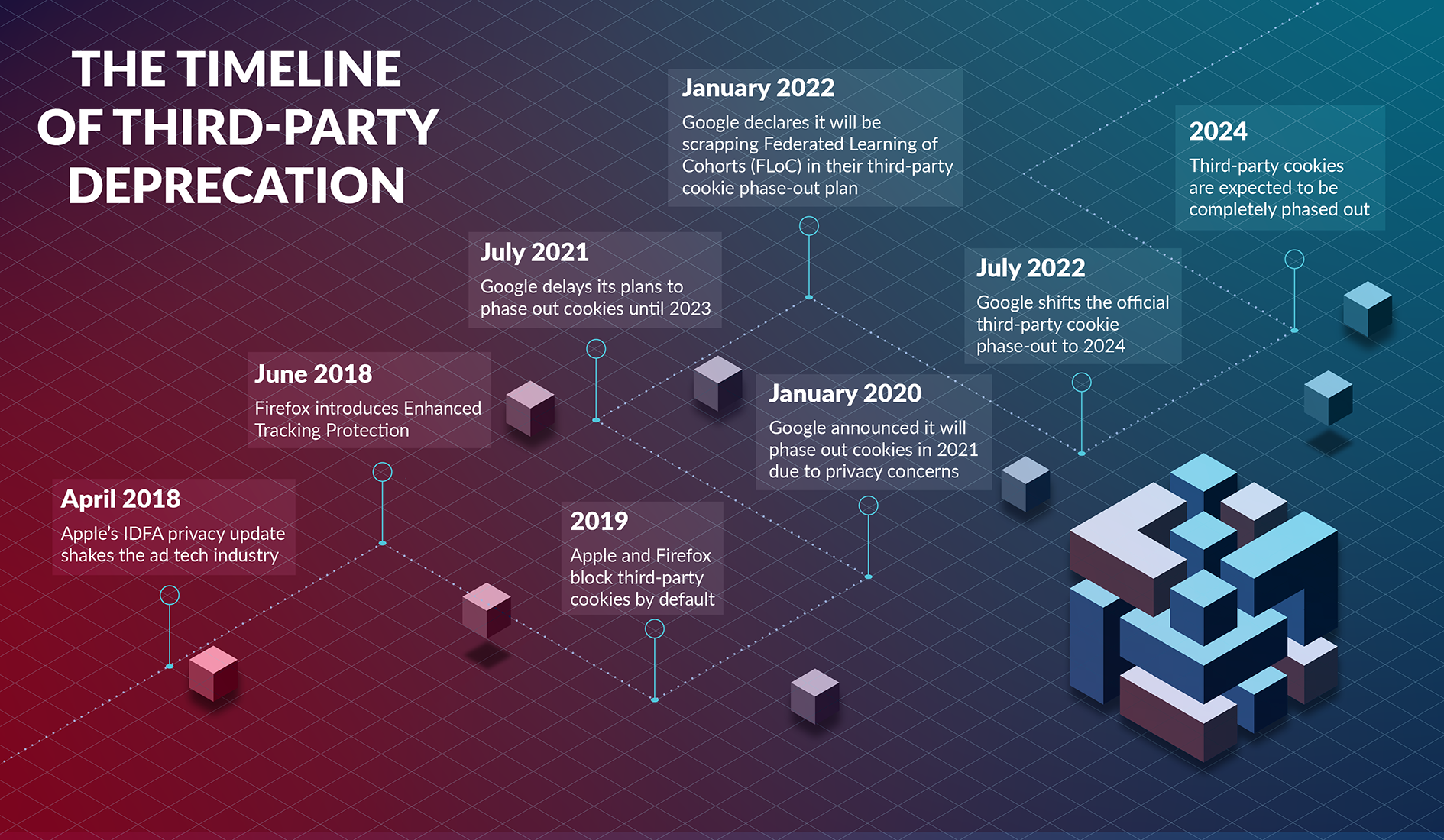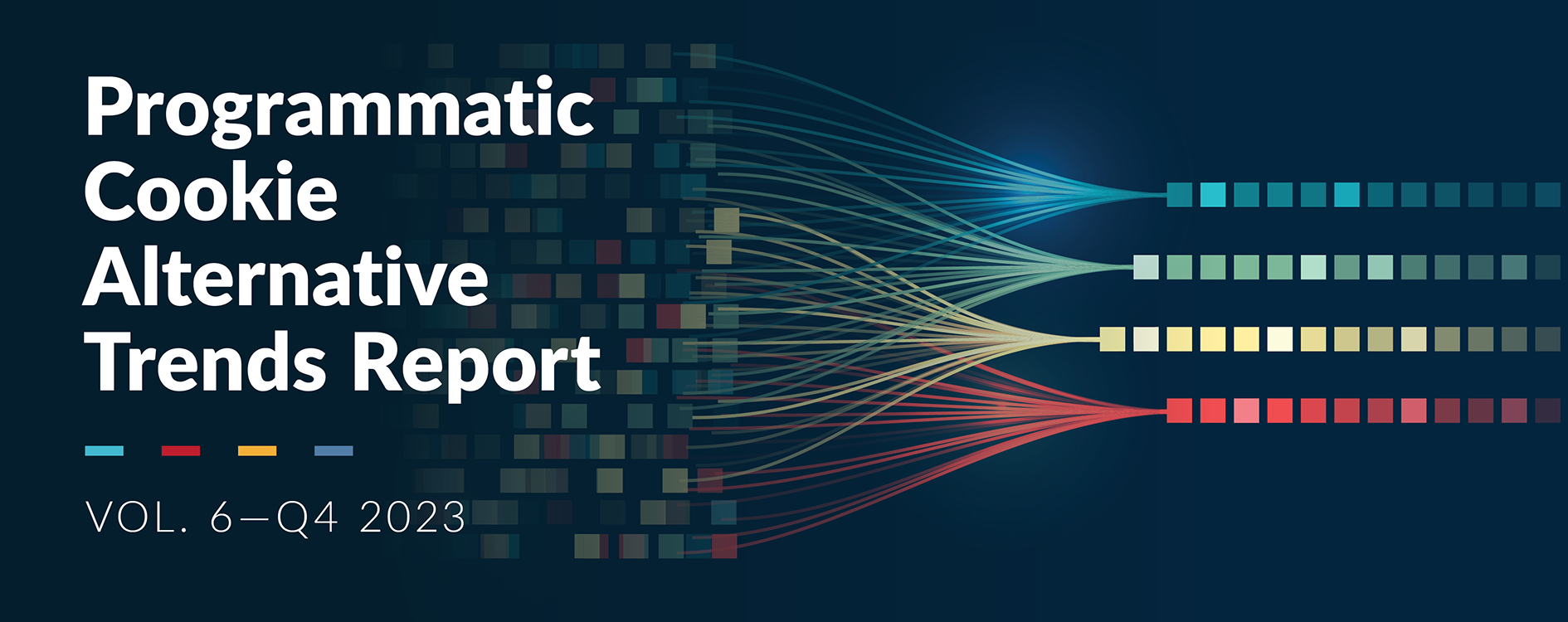In order to help navigate the ongoing changes in digital advertising before 3rd party cookies officially exit, we put together The Complete Guide to a Cookieless World. This guide discusses common industry themes in the ad tech space, breaks down the identity landscape, and much more.
What is a cookie?
Cookies are blocks of data (also known as small text files) that are created when a user visits and browses a website. These blocks of data store information in the user’s browser and are able to recognize the user during future visits.
What do cookies do?
Cookies provide personalized advertising content by storing information about the user.
What is a third-party cookie?
Third-party cookies are placed on domains that originate from an external source. For example, have you ever looked up a pair of shoes, and then saw those exact same shoes in a few ad placements on different websites? This is a prime example of third-party cookies at play. Essentially, third-party cookies are used to track users across multiple sites and target them through ads. Though this has historically been the most common use of cookies amongst advertisers, third-party cookies will be phasing out in 2024.
What is a first-party cookie?
First-party cookies are cookies generated by the host domain, and allow a company to provide a better user experience. For example, first-party cookies save your items in your shopping cart for next time, and store your login information so you don’t have to log in manually each time you click on a website. First-party cookies will not be phasing out.
What does going cookieless mean?
Going cookieless means the absence of third-party cookies as an identifier. Instead, advertisers will use alternative identifiers and/or targeting methods for their programmatic advertising campaigns.
What is identity resolution?
Identity resolution is the process of connecting multiple identifiers from across different platforms and devices in order to target and measure relevant users. Essentially, identity resolution allows advertisers to target users interested in particular products or services while preserving their privacy and security (i.e., no identifiable data, such as name, email address, etc., is used/stored).
What are five cookieless alternatives to third-party cookies?
- Probabilistic ID solutions – The probabilistic targeting approach essentially uses soft signals to build a user profile. These soft signals can include browser type, device type, and other non-identifiable characteristics.
- First-party data – First-party data is the data shared directly from an audience. An example of first-party data is when names, email addresses, etc. are collected from a form. An additional example of first-party data is subscription-based services.
- Contextual targeting – Contextual targeting is when relevant ads are placed based on the page content (for example, if you’re on a nutrition website, you may see an ad for supplements).
- Universal ID (UID) – A universal ID is an identifier that is attached to a user. This identifier passes on information to approved partners. Universal IDs are enriched with first-party and offline data.
- Google’s Privacy Sandbox – Since third-party cookies are phasing out, Google proposed an alternative; their Privacy Sandbox (which is expected to release in Q3 2023). The Privacy Sandbox replaces third-party cookies with application programming interfaces. These APIs provide anonymized information on conversions and attribution.
Is a subscription-based model the solution to third-party cookies going away?
Although subscription-based models may be a good option for some companies, it is not the end all be all solution to third-party cookie depreciation. Why? Because requiring paywalls to access content restricts equal access to content for consumers. At 33Across, we believe that breaking news should not only be available to paid subscribers as this creates an economic information gap.
Why the move towards cookieless or cookie deprecation?
Because of privacy concerns, Google is phasing out its use of third-party cookies in Chrome; the most commonly-used desktop browser. Google will be joining other browsers like Safari and Firefox that do not currently use third-party cookies.
Is it a good thing that third-party cookies are phasing out?
Pros of third-party cookies phasing out:
- More privacy for consumers
- More power for publishers
- With third-party cookies phasing out, this has brought attention to just how much of a publishers’ inventory is under-monetized. For example, around 50% of a publisher’s revenue is cookieless but many are not capitalizing on that revenue.
Cons of third-party cookies phasing out:
- Many advertisers, publishers, and marketers are not prepared for the phase-out. Lack of preparation can lead to huge monetization issues when the phase-out officially takes place.

Why is cookieless targeting important?
- Buyers can reach new audiences: Targeting cookieless inventory enables buyers to tap into new audiences.
- Increased efficiency: 33Across’ Lexicon solution gives demand partners access to quality audiences with less competition than cookied inventory, creating more efficiency and higher win rates.
- Publishers are able to monetize all of their inventory: Today, publishers earn almost all of their programmatic revenue from 50% of their cookied inventory, leaving their Safari and Firefox inventory under-monetized. 33Across’ Lexicon enables cookieless monetization so publishers can address their entire inventory both today and when third-party cookies phase out.
Who should use cookieless targeting?
With the shift towards a cookieless world, all publishers, DSPs. SSPs, data companies, marketers, and the like should shift their focus to cookieless targeting. Soon enough, it won’t be possible to access the individualized data that most are used to with third-party cookies, so there should be a transition (sooner rather than later) towards cookieless targeting before the phase out in 2024.
33Across’ Lexicon solution has helped multiple publishers to monetize their cookieless inventory.
Check out this AdExchanger article that highlights our partnership with DailyMail.com and how we helped them to monetize 67% of their cookieless inventory.
Are you a publisher and not sure how or where to get started? Then check out our blog, 4 Tips for Publishers: How to Navigate Away from Third-Party Cookies.
What is a DSP?
A DSP, or a demand-side platform, is a cloud-based software that advertisers use to manage ad and data exchange accounts.
What is a SSP?
An SSP, or a sell-side platform, is a software that allows publishers to manage and optimize their ad inventory that they sell programmatically to advertisers.
What is a data clean room?
A data clean room is an environment where two parties can share sensitive information such as customer and enterprise data. The information is encrypted and anonymized and used for marketing purposes, product insights, and a variety of other use cases.
What are match rates?
Match rates are the percentage of users from an audience segment that a demand-side platform (DSP) is able to recognize. They are applied when analyzing the data in online ad tools, such as programmatic bid requests. Match rates allow advertisers to understand the size of their addressable audiences, and all in all, the higher the match rate of a specific audience segment, the greater the DSP addressability.
Outlook for cookieless tracking in 2022 and beyond
A large disruption in digital advertising should be expected when cookies first phase out in 2024. Shifting from third to first-party data will force brands to shift their current process of how they store and use data.
Publishers, DSPS, SSPs, data companies, and more will have to decide what solution they will use in order to best address their cookieless inventory. 33Across’ identity solution, Lexicon, an identity solution created specifically to help publishers, SSPs, DSPs, and data companies succeed without cookies.
33Across CEO, Eric Wheeler, provided his insights on the outlook for 2022 and beyond.
How do I get started with cookieless targeting?
Here are some helpful resources where you can learn more about 33Across and the benefits of going cookieless:
Are you ready to get started with Lexicon? Contact us today.








